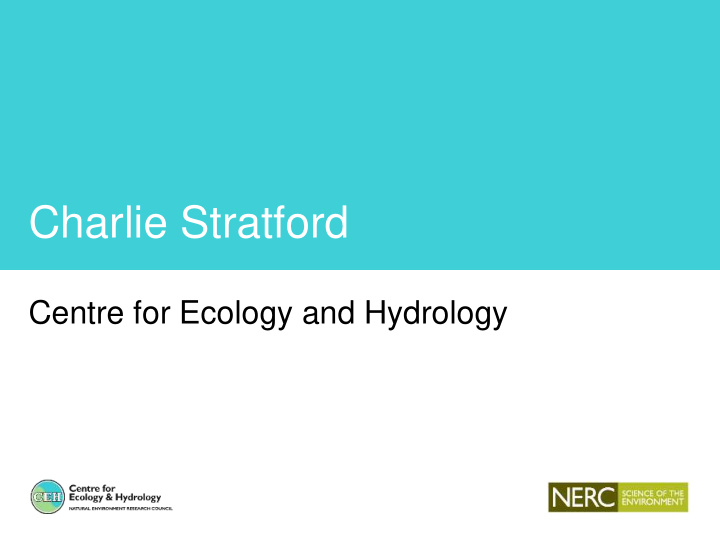



Charlie Stratford Centre for Ecology and Hydrology
Overview of relevant activities • Introducing myself • CEH work in the Fens • Natural Capital KE Fellowship • UK Environmental Observation Framework
A bit about me Started at CEH in November 2001 The Hydro-Ecology and Wetlands Group Initially lots of fieldwork Now doing more office-based work
Day 3
Day 3 – a bit later on.
Restoring a drained landscape • Tadham Moor, a 22 ha site within the Somerset Levels and Moors ESA. • W eston super Mare Much of the land has been drained for agriculture. • Over the past 10 years some areas have been restored by raising water levels. Glastonbury Monthly mean ditch water-levels at Tadham Moor • This site presents a great B ridgewater 2.50 opportunity to study the effects of different water 2.30 Water level (maOD) level management 2.10 strategies in a small spatial 1.90 area. 1.70 1.50 Jul-97 Jul-98 Jul-99 Jul-00 Restored Drained Mean Field Level
CEH Work in the Fens
The Great Fen Restoration • CEH assessed the feasibility of 13 restoration, focusing on water 12 availability and climate change 11 10 • Insufficient water in summer to support that restoration 09 programme; average summer Accumulated 08 water deficit shortfall ≈ 3.5 -Mm 3 (Mm 3 ) 07 for period of • Winter pumping of floodwater from 06 highest risk catchment >-3-Mm 3 in most years 05 05 • Solution: use fen to store winter 04 flood water for use in summer? 03 • But, shortfall may be 7-11_Mm 3 by 02 2080 … 01 Baseline 2020s 2050s 2080s Climate change scenarios
Ecohydrological Modelling
Modelling Conclusions Problem • 30 km 2 of wetland restoration would not be sustainable in the long term under a changing climate. Proposed Solution • increase the depth of the proposed habitat reservoir to 3.5 m to reduce evaporative losses. The refined design provides significant volumes of temporary flood storage in S4 reedbed. Largely sustainable under the UKCIP02 'medium-high' emissions scenario in the 2050s.
CEH Core Monitoring Activities Rainfall, water level and soil moisture collected at these sites
Wicken Fen – Evapotranspiration • Found differences in temperature and humidity between within and outside Wicken Fen. • Temperature lower and vapour pressure higher within the fen. • Expected influence on evapotranspiration. • Wetland micro-climate results in 7% reduction in annual evapotranspiration compared to nearby arable farmland.
Defra Lowland Peat Project • Large scale quantification of greenhouse gas fluxes from lowland peatlands.
River Glen Integrated Study Aim: • to evaluate and develop an agreed approach with key stakeholders toward sustainable water resource management. • to develop a partnership approach to the delivery of the necessary management mechanisms and infrastructure. • Challenge of future water availability. • Workstreams proposed to achieve the study aims.
Stakeholder Engagement Lincolnshire County Council South Lincolnshire Fens - Fens Water-ways Link Partnership - Flood risk team Lincolnshire Wildlife Trust Black Sluice IDB River Glen Integrated Fens Agricultural Welland & Deepings Catchment Management Water Group IDB Plan Anglian Water Environment Agency - WFD - Water Resources Natural Waterside Garden - Environmental monitoring England Centre - Fisheries - Biodiversity
Hydrological and Ecological Datasets % of land cover type for each focus area 100 90 HydroGeology 80 Arable and horticulture Broad leaved, mixed and yew woodland 70 • Highly complex hydrogeology Percentage Cover Built up areas and gardens 60 Coniferous woodland • 50 Partly faulted sequence of permeable and weakly permeable strata overlying the main LL aquifer Dwarf shrub heath 40 Fen marsh and swamp • Confining layers to the east 30 Freshwater 20 Improved grassland – West Glen flows mainly over LL formation 10 Inland rock Neutral grassland 0 – East Glen flows over less permeable material (Upper Estuarine Series) A15 to South East Glen at Glens and Other West Glen at Rough low-productivity grassland Forty Foot Mansthorpe Fens Target Shillingthorpe Fens Area • Swallow holes promote considerable aquifer recharge Focus Area – Particular controlling influence on the West Glen
Work stream 1 – Creation of Wetland Features • Four areas for wetland restoration and/or creation have been identified. • A mixture of open water and reed bed water storage areas surrounded by a mosaic of wetland habitats including areas of raised water level would meet both habitat and water supply needs. • Pilot projects will trial and develop water efficient farming methods and investigate the use of mineral extraction areas for provision of water storage and habitat creation.
NERC Knowledge Exchange Fellowship Natural Capital and Healthy Local Economies
Knowledge Exchange Fellowship • UK Government is committed to promoting vibrant local economies supported by a healthy natural environment. • White Papers – 2010 Local Growth • 2011 Natural Environment • • Local Enterprise Partnerships (LEPs), along with Local Nature Partnerships (LNPs).
Local Enterprise Zones
How can NERC-funded research help? NERC Valuing Natural Capital NERC BESS Nature Mapping Programme Programme Systematic NERC GI LWEC Network Reviews Innovation Assessment Valuing ADVENT Tool R&D Marine ES
UK EOF • Launched in 2008 • CEH has taken over the Secretariat Role 1. Develop a holistic picture of overall evidence needs 2. Share knowledge and information on observation plans, programmes and data 3. Enable effective and transparent decision making processes 4. Enable funding for observation programmes to be effective, transparent and capable of supporting the long-term needs of the UK 5. Build a strong community that provide evidence in an efficient and effective manner
Thank You
Recommend
More recommend